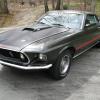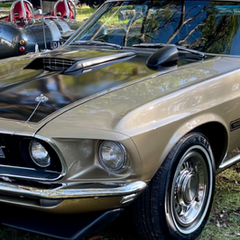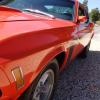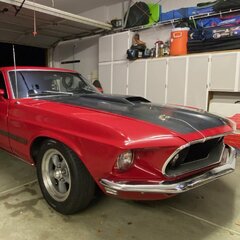-
Content Count
2,134 -
Joined
-
Last visited
-
Days Won
86
Reputation Activity
-
 Mach1 Driver got a reaction from RPM in Bandwidth issue
Mach1 Driver got a reaction from RPM in Bandwidth issue
I tried to "Like" Ben's post, but that is unfortunately still broken for me. Anyway, I'm happy for the coming changes. With all the bot posts and my anti-virus program telling me the site isn't secure, I was seriously considering not returning to the site.
-
 Mach1 Driver got a reaction from RPM in 69 Front Valance Assembly
Mach1 Driver got a reaction from RPM in 69 Front Valance Assembly
I've not seen a book with a red cover. I have the blue Forel Part and Body Illustrations information, and it is about as good as it gets. If you have Osborn, it may be more of the same. The Helm manual may have a few more illustrations and a very brief description of what to do, but not much, and not very helpful.
-

-
 Mach1 Driver got a reaction from RPM in Parkerizing
Mach1 Driver got a reaction from RPM in Parkerizing
In case anyone is interested in seeing the difference between zinc phosphate and manganese phosphate, see below. This was done following Palmetto's instructions, part of which is to sandblast within an hour of application. Since I had three media grits I did one each for zinc and one each for manganese (total of 6). They were Garnet 110/120, Glass abrasive 75, and Glass bead 9. You shouldn't use glass bead because it polishes the surface and you want the surface to be rough so it will hold more oil. It is the oil that gives the rust protection, not the phosphates. Anyway, there was no discernable difference "visually" between the different grits on the test samples. Zinc is on the left and manganese on the right
-
 Mach1 Driver got a reaction from Maynard in Parkerizing
Mach1 Driver got a reaction from Maynard in Parkerizing
In case anyone is interested in seeing the difference between zinc phosphate and manganese phosphate, see below. This was done following Palmetto's instructions, part of which is to sandblast within an hour of application. Since I had three media grits I did one each for zinc and one each for manganese (total of 6). They were Garnet 110/120, Glass abrasive 75, and Glass bead 9. You shouldn't use glass bead because it polishes the surface and you want the surface to be rough so it will hold more oil. It is the oil that gives the rust protection, not the phosphates. Anyway, there was no discernable difference "visually" between the different grits on the test samples. Zinc is on the left and manganese on the right
-
 Mach1 Driver got a reaction from johnk in Power steering
Mach1 Driver got a reaction from johnk in Power steering
I saw this post on VMF today by Chock, who is the preferred rebuilder of steering components for our cars:
https://www.vintage-mustang.com/threads/restoring-a-classic-mustang.1220913/#post-10922033
Google: Chockostang
-
 Mach1 Driver got a reaction from RPM in Ignition switch starts in the starter in the aux?
Mach1 Driver got a reaction from RPM in Ignition switch starts in the starter in the aux?
Many people have trouble with the ignition circuit, but if we break it down into small chunks it’s not that difficult to understand. Look at the schematic because it shows you how it works, while the wiring diagram shows you how it is wired- they are two different things.
The RUN circuit
If we temporarily forget about the top half of the schematic (starter solenoid and starter), you can see that the part that actually runs the engine is pretty simple. Power starts on the left at the battery and goes to ignition switch terminal B. B is closed to C in “start or run” but right now we are only interested in “run”. From terminal C the power goes through the tach (if your car is so equipped). If you don’t have a tach the wires are just connected together. Then the power goes through the resistor wire. This is to knock the voltage down from 12v to around 5.7v. This lowers the power through the coil and makes the points last longer. Next it connects to the coil Bat terminal, flows through the coil’s primary winding and out the Dist. terminal. Power flows from the coil’s Dist terminal to the distributor. There it connects to the points. For a transformer (the coil) to operate it must have a fluctuating magnetic field. The points opening and closing provide that by turning it on and off over and over again. The points must be gapped properly and be in good condition to allow power to flow through them. The points are attached to the breaker plate, and it has a ground wire that attaches to the body of the distributor. The distributor is bolted down to the block, and the block must have ground straps going to the chassis. That completes the circuit, and All of these wires must be connected securely. The condenser is an old fashioned term for a capacitor. Its only job is to quench the arc across the points so the points last longer. The high voltage circuit begins with the secondary of the coil, then the coil wire that runs from the coil to the distributor cap. The cap must be in good condition with no high voltage arc paths to ground. Likewise with the rotor, and plug wires. The plugs must be gapped properly. That is everything to make the engine run… as long as the timing is set to allow the rotor to swing by the plug wires at the proper instant. The dashed line with arrows shows the hi-voltage path from the secondary coil through the rotor to the plugs, to chassis then back through the chassis to the points and returning to the secondary coil. The Start circuit
Now let’s get the engine started. As we said earlier, power goes from the battery to ignition switch terminal B. When the key is in the “start” position it will go through to terminal S. If you have an automatic transmission it will go through the neutral safety switch. With a manual transmission these wires are just connected together. Then it goes to starter solenoid terminal S and from there through the solenoid coil to ground (chassis). The starter solenoid is just a big relay. The solenoid coil pulls in a set of contacts and closes them. One runs the starter motor and the other goes to terminal I. The wire from terminal I to the coil Bat terminal applies power directly from the battery to the coil. This “shorts out” the circuit we discussed in 1-4 above and instead of 5.7 volts at the coil, now it is a full 12 volts. This gives the coil more power and makes the engine easier to start.
-
 Mach1 Driver got a reaction from TexasEd in Carpet Install
Mach1 Driver got a reaction from TexasEd in Carpet Install
Many people suggest using soldering irons.
This is NPDs kit. The screws with the cone shaped washers are for the bottom of the door panel where the carpet is. I'm not sure what the pop rivets are for- someone here will know.
https://www.npdlink.com/product/mounting-kit-door-panel/104260?backurl=search%2Fproducts%3Fsearch_terms%3Ddoor%2Bpanel%2Bfasteners%26top_parent%3D200001%26year%3D1969&year=1969
ACC Auto Custom Carpet gets the highest marks, mass backed. The Essex cut pile is thick, dense and plush and the top of their line. When last I checked it was 46% cheaper at Rock Auto.
-
 Mach1 Driver got a reaction from TexasEd in Russian Bots Again
Mach1 Driver got a reaction from TexasEd in Russian Bots Again
This is ridiculous; this morning every section of the forum had a post in Cyrillic!
-
 Mach1 Driver got a reaction from det0326 in Carpet Install
Mach1 Driver got a reaction from det0326 in Carpet Install
Many people suggest using soldering irons.
This is NPDs kit. The screws with the cone shaped washers are for the bottom of the door panel where the carpet is. I'm not sure what the pop rivets are for- someone here will know.
https://www.npdlink.com/product/mounting-kit-door-panel/104260?backurl=search%2Fproducts%3Fsearch_terms%3Ddoor%2Bpanel%2Bfasteners%26top_parent%3D200001%26year%3D1969&year=1969
ACC Auto Custom Carpet gets the highest marks, mass backed. The Essex cut pile is thick, dense and plush and the top of their line. When last I checked it was 46% cheaper at Rock Auto.
-
 Mach1 Driver got a reaction from RPM in Missing my 1935 Ford pick up .
Mach1 Driver got a reaction from RPM in Missing my 1935 Ford pick up .
Rock-out Ridge! I believe it was Eric Carmen in 1975.
-
 Mach1 Driver got a reaction from smh00n in Mustang Factoids
Mach1 Driver got a reaction from smh00n in Mustang Factoids
A lot of these are for 69/70:
https://anghelrestorations.com/mustang-factoids/
-
 Mach1 Driver reacted to det0326 in Aod conversation kit.
Mach1 Driver reacted to det0326 in Aod conversation kit.
I use to own this car and sold to a guy that I stay in touch with. He wants to change to 4R for a couple of reasons. First and foremost the 4R has stronger input shaft ( in stock form anyway ) than the AOD and with the electronic shifter will be able to change shift points to anything he wants.
-
 Mach1 Driver got a reaction from Jesse 69 Fastback in Mustang Factoids
Mach1 Driver got a reaction from Jesse 69 Fastback in Mustang Factoids
A lot of these are for 69/70:
https://anghelrestorations.com/mustang-factoids/
-
 Mach1 Driver got a reaction from det0326 in Question - Interior Lighting
Mach1 Driver got a reaction from det0326 in Question - Interior Lighting
Dave, see my post above ^^^
-
 Mach1 Driver reacted to bigmal in 351C issues
Mach1 Driver reacted to bigmal in 351C issues
Try running with the gas cap open/off. This will eliminate fuel tank venting as the cause.
-
 Mach1 Driver reacted to RPM in 1969 Coupe with 302 transmission?
Mach1 Driver reacted to RPM in 1969 Coupe with 302 transmission?
The simplist and without mods would be that C4, if he rebuilt it correctly. While it may not be the optimal transmission, I'll all for getting these Mustangs on the road without necessarily building the perfect car.
-
 Mach1 Driver got a reaction from det0326 in 1969 Coupe with 302 transmission?
Mach1 Driver got a reaction from det0326 in 1969 Coupe with 302 transmission?
Don't forget the FMX, that's what came behind the 351W in my Mach. They are strong and reliable and should have the same bolt pattern as a 302, since AODs fit all these blocks, the FMX should too. I'd stick a 4R70W on there, as its the last and most perfected version of the AOD- then you get overdrive.
-
 Mach1 Driver reacted to RPM in 69 convertible restomod help/advice
Mach1 Driver reacted to RPM in 69 convertible restomod help/advice
I drive my 69 daily and would recommend stock factory parts. Preferably from 1969. I put many Mustang parts on my 69 from newer Mustangs, but it's a lot of work and sometimes affects a few other parts and modifications. If you want front discs I'd use some from a 69. I have manual discs, which make it easy to stop. My brother has manual drums on his 69 SCJ which work as well as mine. Adding power brakes sounds simple enough, but is a lot of work and involves different parts, pedal, pedal hanger, booster etc.
-
 Mach1 Driver got a reaction from RPM in 1969 Coupe with 302 transmission?
Mach1 Driver got a reaction from RPM in 1969 Coupe with 302 transmission?
Don't forget the FMX, that's what came behind the 351W in my Mach. They are strong and reliable and should have the same bolt pattern as a 302, since AODs fit all these blocks, the FMX should too. I'd stick a 4R70W on there, as its the last and most perfected version of the AOD- then you get overdrive.
-
 Mach1 Driver got a reaction from det0326 in 69 convertible restomod help/advice
Mach1 Driver got a reaction from det0326 in 69 convertible restomod help/advice
These kits you are contemplating are from aftermarket manufacturers. Much of it will not fit without problems. The further you venture from a stock 69, they more problems you will encounter. Also, Ford build parts from newer models will not just drop-in and operate trouble free- they weren't designed for your car. You see a number of Coyote Mustangs for sale, and I believe it is because they are not satisfied with the end result. You end up with odd combinations that just don't work well together.
These cars gave hundreds of thousands of trouble free miles. The technology is 50+ years old, but it still works fine. If you want to add an EFI, fine- but stick with an engine that was originally offered in the car; a six or SBF, or BB of the era. Adding aluminum heads is an easy way to increase horsepower. A Coyote just doesn't fit well in there in either width or height. You would need to get rid of the shock towers and revamp the entire front suspension.
You can upgrade to an AOD or 4R70W trans from newer Fords because they will bolt right up to a SBF, but even then it will need an aftermarket trans support and shortened drive shaft. This is a fairly easy upgrade and well worth it. The 4R70W will require an electronic transmission control, but the 4R70W is the last of the AOD line, and has all the problems fixed. Expect a custom exhaust, since the overdrive transmissions are wider than their predecessors. The linkage is different but can be modified to work well.
There are a huge number of carburetors available but be cautious what you stick on top of the engine as the 69 does not have a lot of clearance to the hood. These new carbs are the same height as the old Ford carbs, but aftermarket intake manifolds are all taller. Same goes with EFI, it isn't any taller but watch the manifold. For EFI you need a new fuel delivery system: tank, pump, fuel and return lines, and regulator to make it work. Don't expect anything electronic to last forever (like an EFI). Electronics aren't warrantied for longer than 10 years and equivalent parts are no longer made or supported in as few as 5 years. Heck, we hear all the time that brand new parts don't work.
To do all these things you need to be mechanically inclined. It will take determination and perseverance to get it all to work together reliably. You become the engineer. I'm not trying to discourage you, but you need to proceed with your eyes wide open. Advice is available, but you are about to go down a path that most people can not and should not travel. In the end it will be worth it.
Are you from Georgia? I'm northwest of Atlanta.
-
 Mach1 Driver reacted to Mike65 in Cool Santa video from Rick @ NPD.
Mach1 Driver reacted to Mike65 in Cool Santa video from Rick @ NPD.
You will all enjoy this.
(1) Santa Wants Horsepower | NPD - YouTube
-
 Mach1 Driver reacted to ThePoose in Sunvisor Issue
Mach1 Driver reacted to ThePoose in Sunvisor Issue
AGS Brake Lube is like Frank's Red Hot. I put that sh*t on everything.
-
 Mach1 Driver reacted to det0326 in 351w Drivers Side Exhaust Removal
Mach1 Driver reacted to det0326 in 351w Drivers Side Exhaust Removal
Don't know if it will work in your case or not but I have gained a little more clearance by removing the transmission mount bolts. With my foot put some pressure on tail of transmission and actually slide it over some. I was taking my header out bottom tho. If you just need a tiny bit more clearance at back part of engine it might allow you to remove from the top.
-
 Mach1 Driver reacted to 69Mach1 M code in Which pin for solenoid S terminal?
Mach1 Driver reacted to 69Mach1 M code in Which pin for solenoid S terminal?
While we're on the subject of solenoids, I would recommend to anyone who has an older Ford vehicle with the solenoid mounted on the inner fender to occasionally have someone start the vehicle while you observe the solenoid. This should be done with the ambient lighting low enough to visually observe an electrical arc if one is present, preferably at night.
I had an older Mustang with the original solenoid still in it, no problems with starting at all. My Dad started the vehicle while I just so happened to be looking into the engine bay and sure enough, a large arc of electrical current ran from the housing to one of the mounting screws. After close examination I could see a small fracture had formed in the housing after about 50 years of age and heat cycling.






